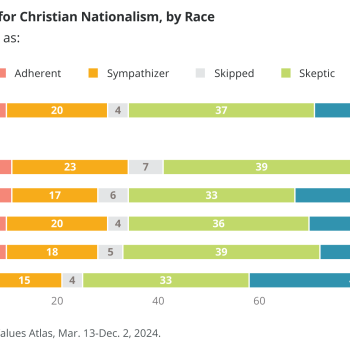In the last month, Franklin Graham called for a moratorium on Muslim immigration. Polls seemed to show considerable evangelical support for Donald Trump. Jerry Falwell declared, “If more good people had concealed-carry permits, then we could end those Muslims before they walked in and killed them.”
Graham and Falwell represent a particular strain of Christianity. Large numbers of evangelicals find these statements unbiblical and embarrassing. A gathering last week of 16,000 evangelical university students in St. Louis offers a helpful glimpse into moderate and progressive sectors of evangelicalism that don’t make the news so often.
 For over half a century, students affiliated with InterVarsity Christian Fellowship chapters at state universities have met between Christmas and New Years for a four-day, triennial convention. For decades, they met at the University of Illinois’s basketball arena (which is why the convention still goes by the term Urbana). More recently, they have gathered in downtown St. Louis, just miles away from Ferguson where Michael Brown was killed.
For over half a century, students affiliated with InterVarsity Christian Fellowship chapters at state universities have met between Christmas and New Years for a four-day, triennial convention. For decades, they met at the University of Illinois’s basketball arena (which is why the convention still goes by the term Urbana). More recently, they have gathered in downtown St. Louis, just miles away from Ferguson where Michael Brown was killed.
Planners and speakers in St. Louis, aware of their location, made a bold statement in support of Black Lives Matter. On the evening of December 28, 2015, the worship band wore Black Lives Matter t-shirts while leading gospel songs. Michelle Higgins, director of Faith for Justice in St. Louis, explained, “Black Lives Matter is not a mission of hate. It is a movement on mission in the truth of God.” In less than twenty-four hours, InterVarsity’s stock of Black Lives Matter t-shirts sold out in less than twenty-four hours.
Higgins’s endorsement was echoed by many other speakers at Urbana ’15. Christena Cleveland, defining white privilege as “the way society accommodates some people while alienating other people,” declared, “I think it’s one of the most important things happening in the history of the United States. … [it’s] all about bringing world into alignment with how God sees the world.” Yetanother speaker, a black grandmother, described how her 31-year-old son, who walks around with hanging pants and a near perfect SAT score, is regularly racially profiled. “It’s personal,” she told the convention.
Missing from the breathless reporting (one critic titled his piece “Dorothy, This Is Not Your Parents’ InterVarsity Anymore”) on Urbana ’15 was a sense of historical perspective. As I’ve written about at length in my book Moral Minority, InterVarsity in fact has a long tradition of social activism. In 1967, for example, students drafted a resolution complaining that “there are no black men in leadership positions on the national staff.” Following Urbana ‘67, InterVarsity’s magazine wrote that very little “escaped criticism at the convention. … Anything that seemed to show intolerance came under their indictment, with impatience toward racism leading the list.”
At Urbana ‘70 the funky strains of Soul Liberation, a band of black musicians wearing afros, colorful outfits, and African symbols, welcomed attendees. The mostly white audience hesitated at first, unsure of what to make of “Power to the People,” a song full of idioms from the emerging Black Power movement. But the swell of students soon rose to its feet to sing and clap along, delighted by the radical departure from the usual hymns.

Tom Skinner, a black evangelist, then rose to deliver the evening sermon, a searing critique of racial prejudice in American society. Cheered on by over 500 black students who had arrived early to secure seats right in front of the podium, Skinner preached, “You soon learn that the police in the black communities become nothing more than the occupational force in the black community for the purpose of maintaining the interests of white society. … You soon learn that what they mean by law and order is all the order for us and all the law for them.”
Echoing Martin Luther King, Jr., Skinner contended that the white evangelical moderate remained strangely silent. “Christians supported the status quo, supported slavery, supported segregation.” “Even today, evangelicals “go back to their suburban communities and vote for their law-and-order candidates who will keep the system the way it is.”
Skinner his sermon with a rhetorical flourish: “Go into the world that’s enslaved, a world that’s filled with hunger and poverty, racism and all those things that are the work of the devil. Proclaim liberation to the captives, preach sight to the blind, set at liberty them that are bruised. Go into the world and tell them who are bound mentally, spiritually, physically: The liberator has come!” Skinner received a standing ovation.
One observer described the response as deafening and electric, “the most powerful moment that I’ve ever experienced at the conclusion of a sermon.” For many students, Skinner’s speech portrayed all that was wrong, and suddenly hopeful, about evangelicalism.
The theme of a complicit white church again threaded its way through Urbana ‘15. Speaker after speaker confessed to inaction in the wake of Ferguson. That evangelicals, forty-five years after Urbana ’70, had to confess yet again seems so wrong. That these evangelicals are so forcefully speaking against structural inequalities seems hopeful yet again.












